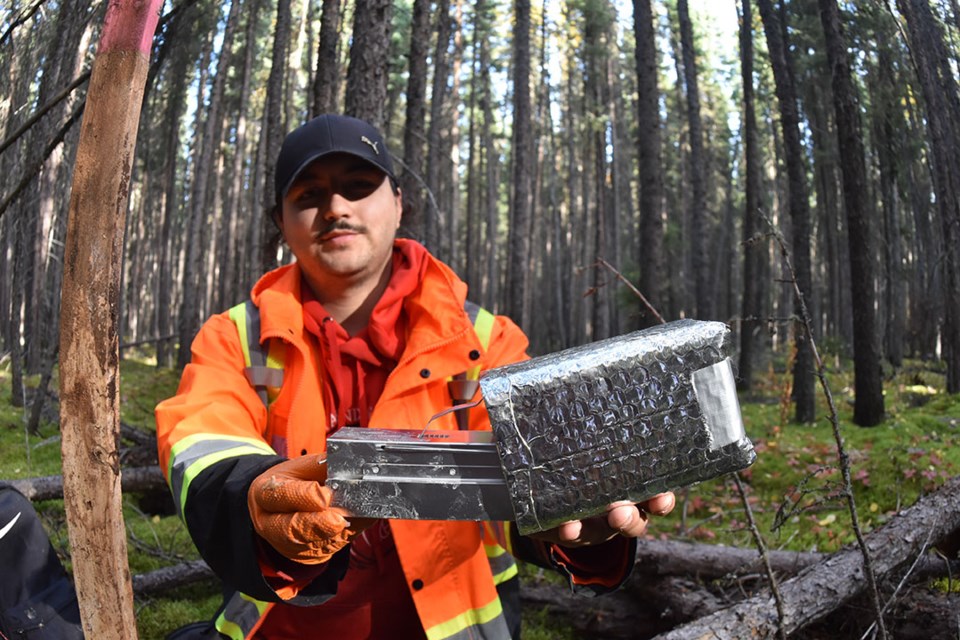My name is Tyler Halliday, and I am a second year Natural Resource Management Technology (NRMT) student. The NRMT program is for those interested in a career in conservation and environmental science. It is offered at the University College of the North in The Pas and is a two-year program. During second year, students travel to a remote facility on Tramping Lake, located in the Grass River Provincial Park. Students and faculty drive two hours north to Wekusko Falls and then haul in all equipment and supplies by boat.
Students live at the Tramping Lake research facility for three weeks. Cabins are remote, with no running water. Generators are used for electricity. Tramping Lake is the highlight of the NRMT program and is a great learning experience. During their stay, students learn about and perform various exercises related to forestry, environmental assessment, wildlife management and fisheries management.
One of the main activities that students participate in while at Tramping Lake is a small mammal survey. The small mammal survey analyzes and compares the population of small mammals such as voles and shrews in two locations. The first area is an old growth forest known as the “Old Growth Grid.” The second site is located near a Manitoba Hydro line along Provincial Road 392, known as “Hydro Grid.” Each location has a 10,000-square-metre grid established on the land. There are 10 lines labelled with letters A-J and 10 plots per line numbered 1-10 (plot one is A1, plot two is A2, etc.). Each plot is 10 metres square in size.
Two small mammal traps are laid at each plot, for a total of 200 traps per grid, or 400 traps for the entire survey. Each trap is baited with a mix of protein and peanut butter and set within designated plots. The point of the survey is to determine which of the two sites will catch more small mammals. For instance, is the population higher in the pristine old growth forest or the disturbed patch of forest along the hydro line?
On top of monitoring the small mammal survey, I decided to run my own survey. I made two additional lines with the same dimensions as the main survey (10 plots each,10 square metres in size) at both sites. I called my lines the K lines. But my survey differed from the main survey in one big way, I used live traps. The snap traps used for the small mammal grid survey euthanize the animals caught in the traps. I wanted to compare my lines to the larger grids and see if I would catch higher or lower amounts of small mammals while letting the animals live.
The traps I used were called Longworth traps. I baited these live traps with a protein and peanut butter mix and celery. Celery is required because the animals need a water source while they’re in the live trap. I also put scraps of cotton in the traps for bedding. I camouflaged the traps and checked on them everyday after I had finished monitoring the snap traps. I put two traps at each of my K-labelled plots for a total of 40 live traps separated between the two sites.
Upon a successful live trapping, I marked the caught animal with some non-toxic white-out to prevent counting the animal twice. The idea was the larger survey should catch more animals than me because it covered a larger area, or would it? My theory was if I caught one animal with my 10 plots per line, then the main survey should catch close to 10 animals with its 100 plots per grid. The results were interesting.
The first day I caught an animal in my live traps I expected the main survey to catch more animals than me, but that didn’t happen. In fact, I was more successful than the main survey. My most successful day had me catching three animals, while the main survey was not catching anywhere near 30 animals. It was barely catching three animals with 400 traps! I started to wonder what it was about my live traps that were attracting more animals versus the snap traps. Was it the way I baited my traps? Or did the snap traps have a residual smell after the captured animals were removed?
I don’t have a clear answer as to why my traps seemed to be more successful, but I think that it poses an important question to the scientific community. Do we need to be euthanizing animals to acquire our data, or is there a better way? I think all animals deserve a chance at a full life, particularly the little ones.
Tyler Halliday is a second-year Natural Resource Management Technology student at University College of the North in The Pas.




